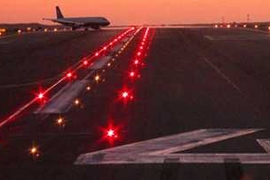At the recent 2016 Military Sensing Symposia (MSS) Detectors and Materials Conference, MIT Lincoln Laboratory was presented with the Herschel Award for its development of digital-pixel readout integrated circuits. The Herschel Award, given by the MSS Specialty Group on Detectors and Materials, recognizes a major breakthrough in infrared device science or technology.
Digital-pixel readout integrated circuits can achieve very high dynamic range, high sensitivity, and fast data rate compared to conventional technology. The MIT Lincoln Laboratory team received the award for its work on the Vital Infrared Sensor Technology Acceleration (VISTA) program. The VISTA program was a tri-service program managed by the U.S. Army's Night Vision and Electronic Sensors Directorate; it was stood up to improve the nation's capability in advanced infrared focal plane array technology for military sensors.
The Herschel Award, named for Sir William Herschel, a British astronomer who is credited with discovering infrared radiation, is one of the most prestigious awards offered by the MSS. It is not bestowed annually but is given when the selection committee, composed of leading members of the infrared scientific community, determines an individual or organization has contributed a significant advancement to the infrared science and industry community. Until this year, the Herschel Award had not been presented since 2011.
"This award is the result of the hard work of many engineers over nearly 15 years. It is because of the dedication and hard work of some of the most exceptionally talented engineers that we have been able to bring the digital-pixel dream to a reality," said Michael Kelly, associate leader of Lincoln Laboratory's Advanced Imager Technology Group and a principal investigator on the development team. "We have been very fortunate to have received strong support from a number of U.S. government sponsors. In particular, the VISTA program provided our team with the platform and funding needed to rapidly mature the technology and make the advances for which we have been recognized with this award," he added.
The MSS is a set of conferences on military sensing technologies. These conferences, managed by specialty groups, address a broad range of sensing domains, including detectors and materials, radar, infrared countermeasures, passive and active electro-optical sensors, missile defense sensors, and more. The MSS runs a fellowship program to recognize individuals whose body of technical work contributed significantly to military sensing and an awards program to recognize individuals and organizations who have made important breakthroughs in sensing technologies.






